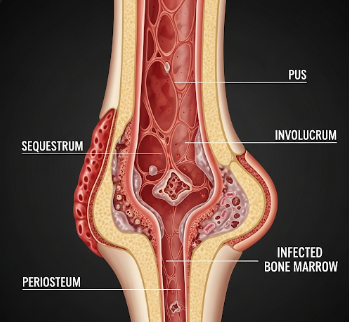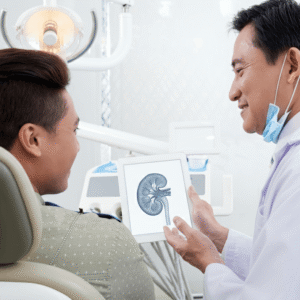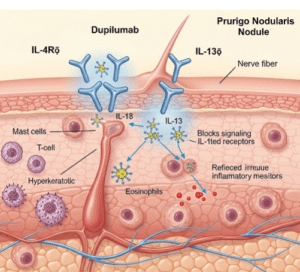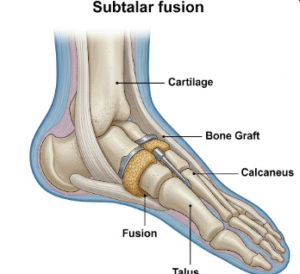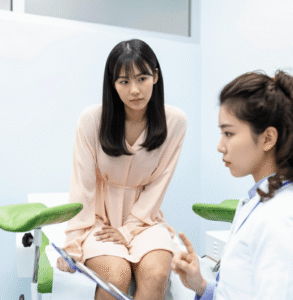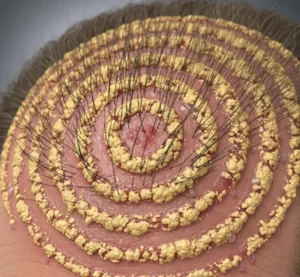Overview
Bone infection, medically termed osteomyelitis, is a serious condition in which bacteria, fungi, or other pathogens infect the bone tissue, leading to inflammation, pain, and potential bone destruction. Osteomyelitis can affect any bone but most commonly involves the long bones of the arms and legs, spine, pelvis, or jaw.
In Korea, osteomyelitis is treated in specialized orthopedic and infectious disease centers. Korean hospitals emphasize early diagnosis, precise microbial identification, and a combination of antibiotic therapy and surgical intervention. Modern approaches aim to eradicate infection, preserve bone integrity, and restore mobility, while minimizing complications such as chronic infection or sepsis.
What is Bone Infection (Osteomyelitis)?
Osteomyelitis occurs when microorganisms invade bone tissue, triggering the body’s immune response. This results in bone inflammation, reduced blood supply, and potential necrosis. Infection can reach the bone through:
- Hematogenous spread: Bacteria travel through the bloodstream from another infection site
- Direct inoculation: Open fractures, surgery, or trauma
- Contiguous spread: Infection from nearby soft tissue or joints
Bone infection may be acute (developing over days to weeks) or chronic (lasting months to years), with chronic cases often requiring long-term management.
Symptoms
The symptoms of osteomyelitis can vary depending on age, infection site, and severity:
- Localized bone pain and tenderness
- Swelling, redness, and warmth over the affected area
- Fever and chills indicating systemic infection
- Limited mobility or difficulty using the affected limb
- Fatigue, malaise, and general discomfort
- Pus drainage from surgical wounds, open fractures, or sinus tracts in chronic cases
- Delayed growth or deformity in children with long bone infections
Chronic osteomyelitis may present with recurrent pain, persistent drainage, or sinus tract formation, sometimes months after initial injury or surgery.
Causes
Osteomyelitis is usually caused by bacterial infections, most commonly Staphylococcus aureus, including methicillin-resistant strains (MRSA). Other pathogens include Streptococcus species, Gram-negative bacteria, and fungi.
Common causes include:
- Open fractures or traumatic injuries allowing bacteria to enter the bone
- Surgical procedures or orthopedic implants
- Bloodstream infections from skin, urinary tract, or respiratory sources
- Contiguous infections from nearby wounds, ulcers, or soft tissue infections
- Diabetic foot infections increasing risk of bone involvement
- Immunocompromised states such as HIV, cancer, or long-term steroid use
Risk Factors
- Diabetes mellitus: Poor wound healing and immune dysfunction
- Peripheral vascular disease: Reduced blood supply impairs bone defense
- Recent surgery or orthopedic implants
- Open fractures or severe trauma
- Chronic wounds or pressure ulcers
- Immunosuppressive therapy or conditions
- Children and elderly individuals are at higher risk due to developing or weakened immune systems
Complications
Untreated or poorly managed osteomyelitis can lead to severe complications:
- Chronic infection: Persistent bone infection that is difficult to eradicate
- Bone necrosis: Death of bone tissue due to poor blood supply
- Pathologic fractures: Weakened bones prone to breaking
- Sepsis: Life-threatening systemic infection
- Growth disturbances in children due to involvement of growth plates
- Amputation: In extreme cases where infection destroys bone and surrounding tissue
- Spread to adjacent joints or soft tissues, leading to arthritis or abscess formation
Prevention
Preventive measures focus on infection control, early treatment of wounds, and maintaining overall health:
- Prompt care for fractures, cuts, and surgical wounds
- Strict hygiene and sterilization practices in hospitals and clinics
- Early treatment of infections elsewhere in the body
- Diabetes management to prevent chronic wounds and infections
- Protective measures in high-risk occupations or sports
- Vaccinations and health monitoring for immunocompromised individuals
Treatment Options in Korea
Diagnosis
Korean hospitals utilize advanced diagnostic tools to identify osteomyelitis promptly and accurately:
- Physical examination: Assess pain, swelling, and wound drainage
- Imaging: X-rays, MRI, CT scans, or bone scans to detect bone involvement and abscess formation
- Laboratory tests: Blood counts, inflammatory markers (CRP, ESR), and cultures
- Bone biopsy: Essential for pathogen identification and antibiotic sensitivity testing
- Microbiological studies: Identify bacterial or fungal species causing infection
Medical Management
- Antibiotic therapy: Targeted based on culture and sensitivity; may last several weeks
- Intravenous antibiotics: Often required for acute or severe infections
- Oral antibiotics: Used for long-term suppression in chronic cases
- Pain management: Analgesics and anti-inflammatory medications
Surgical Management
Surgery is indicated when infection is persistent, severe, or involves dead bone tissue:
- Debridement: Removal of infected and necrotic bone and tissue
- Sequestrectomy: Extraction of dead bone segments
- Drainage of abscesses
- Reconstruction or bone grafting after infection control
- Amputation: Rare, reserved for cases with extensive bone destruction or life-threatening infection
Supportive Care
- Immobilization of affected limb to aid healing
- Physical therapy: Restores mobility and strength after infection control
- Nutritional support: Ensures adequate protein, vitamins, and minerals for bone repair
- Psychological support: Addresses anxiety and stress associated with chronic infection
- Regular follow-up: Monitors infection resolution and prevents recurrence
Prognosis
The prognosis of osteomyelitis in Korea depends on timely diagnosis, severity, and patient health:
- Acute osteomyelitis treated promptly has good outcomes with complete recovery
- Chronic osteomyelitis may require long-term antibiotics and multiple surgeries
- Early intervention minimizes complications like bone necrosis, fractures, or systemic infection
- With Korea’s advanced imaging, microbiology, and surgical capabilities, most patients achieve infection resolution, preserved bone function, and improved quality of life

